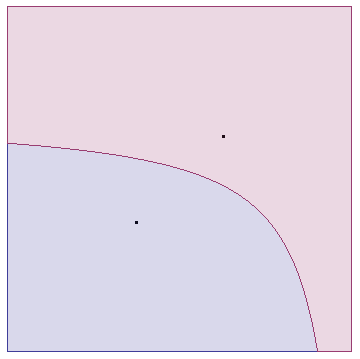Let us first define two positive definite matrices:
M1 = {{2, -6}, {4, 8}}; M2 = {{2, 3}, {4, 8}}; then set two points p1={-1,-1} and p2={1,1}. Finally we define an anisotropic distance function, namely:
d[q1_, q2_, M_] := Sqrt[(q1 - q2).M.(q1 - q2)] When trying to plot the anisotropic Voronoi cells as follows:
Show[ Graphics[Point[{p1, p2}]], RegionPlot[ { d[{x, y}, p1, M1] < d[{x, y}, p2, M2], d[{x, y}, p1, M1] > d[{x, y}, p2, M2] }, {x, -4, 4}, {y, -4, 4} ] ] I obtain the following image:

My question is: How can I get rid of the underlying mesh, which is visible in this example?
Two remarks:
- Removing the points' plotting also removes the mesh.
- Adding something like
Mesh->Noneto theRegionPlotdoesn't help.
Edit:
It seems this problem is specific to Mac OS X. Here is the Options[RegionPlot] output:
{AlignmentPoint -> Center, AspectRatio -> 1, Axes -> False, AxesLabel -> None, AxesOrigin -> Automatic, AxesStyle -> {}, Background -> None, BaselinePosition -> Automatic, BaseStyle -> {}, BoundaryStyle -> Automatic, ColorFunction -> Automatic, ColorFunctionScaling -> True, ColorOutput -> Automatic, ContentSelectable -> Automatic, CoordinatesToolOptions -> Automatic, DisplayFunction :> $DisplayFunction, Epilog -> {}, Evaluated -> Automatic, EvaluationMonitor -> None, FormatType :> TraditionalForm, Frame -> True, FrameLabel -> None, FrameStyle -> {}, FrameTicks -> Automatic, FrameTicksStyle -> {}, GridLines -> None, GridLinesStyle -> {}, ImageMargins -> 0.`, ImagePadding -> All, ImageSize -> Automatic, ImageSizeRaw -> Automatic, LabelStyle -> {}, MaxRecursion -> Automatic, Mesh -> None, MeshFunctions -> {#1 &, #2 &}, MeshShading -> None, MeshStyle -> Automatic, Method -> Automatic, PerformanceGoal :> $PerformanceGoal, PlotLabel -> None, PlotPoints -> Automatic, PlotRange -> Full, PlotRangeClipping -> True, PlotRangePadding -> Automatic, PlotRegion -> Automatic, PlotStyle -> Automatic, PreserveImageOptions -> Automatic, Prolog -> {}, RotateLabel -> True, TextureCoordinateFunction -> Automatic, TextureCoordinateScaling -> Automatic, Ticks -> Automatic, TicksStyle -> {}, WorkingPrecision -> MachinePrecision} 

![RegionPlot[] example](https://i.sstatic.net/xYBrh.png)
DensityPlotfor example? What OS and Mathematica version? $\endgroup$Options[RegionPlot]in your question? $\endgroup$